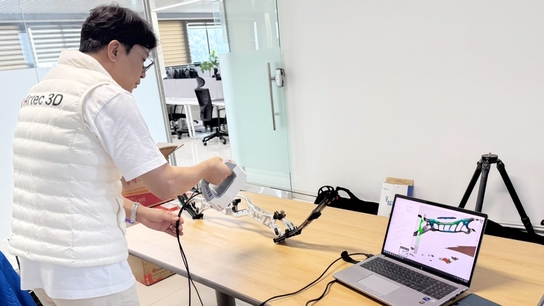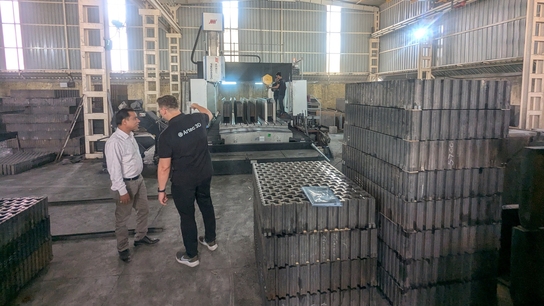Prehistory meets high tech as Artec Leo comes face-to-face with a dinosaur skull
Challenge: To digitize the skull of a triceratops for virtual viewing, academic study, and to create a replica for use in another museum.
Solution: Artec Leo, Artec Studio, a ladder
Results: With a full 3D model of the dinosaur skull, visitors and students are able to view the CU Museum of Natural History’s most popular exhibit despite coronavirus closure.
Dinosaurs – Creatures that have inspired study and research for centuries, and they continue to intrigue millions around the world up to the present. For the preserved remains of one triceratops that roamed the earth in prehistoric times, modern technology has assigned a status that few fellow dinosaur fossils have achieved: digital immortality.
Originally discovered in 1891 near the town of Lance Creek, Wyoming, the skull of this plant-eater was on display at the Smithsonian Institution in Washington D.C. until the late 1970s. It was then loaned to the CU museum, where it now resides; the museum as we see it today was literally built around this skull.

To capture the entire skull, a ladder needed to be used. (Image by David Cano / 3D Printing Colorado)
“The Smithsonian put together an estimate of how much it would cost to knock that wall down, get this thing out, and ship it back to them because they own it, and it was just so expensive and risky that no one wanted to go through with it,” says Nick Conklin, Applications Engineer at 3D Printing Colorado. This means that the skull will remain where it is for the foreseeable future, but with 3D scanning technology, previously impossible opportunities have already started to present themselves.
When Conklin and his colleague David Cano first visited Colorado University’s Museum of Natural History in January of this year, it was for the sale of an Artec Leo 3D scanner. “On the way in, we spotted the triceratops skull and thought ‘Hey, that would be a really cool scan, we should do that sometime!’” Conklin recalls.
For every scanner that 3D Printing Colorado sells, training is included. But for Dr. William Taylor, Curator of Archaeology at the university, already familiar with Artec 3D scanners, another add-on was suggested.
“Dr. Taylor had already used Artec Space Spider quite a bit, and so instead of the training, he elected to have us bring Leo in for one of his classes,” says Conklin. “He wanted us to show his students what can be done with Leo and scanning technology.”
Thus a project of prehistoric proportions began – to digitize a dinosaur skull in its entirety.

The scanning was done as part of a lesson at the university. (Image by David Cano / 3D Printing Colorado)
“For 30 to 40 minutes during one of Dr. Taylor’s night classes, I was scanning the triceratops skull as I was talking to the students – explaining what I was doing, so it was a bit of a show-and-tell teaching moment,” says Conklin. This skull scanning soon caught the attention of CU Media.
“The university’s media relations were all over it, and they wanted to take pictures and videos of a dinosaur being scanned,” says Cano. “Once they got wind of this, we were invited back, and this time instead of a teaching experience, it was more of a film photoshoot,” adds Conklin.
During their second scan, one thing enabled even better access for the scanning process: a ladder. “With the ladder, I was able to get some details that I had missed previously, just because there was a more conducive environment for that,” Conklin says.
The scan took a total of 30 minutes, while scan processing was completed entirely in Artec Studio 3D software within two hours.
Using Leo, most surfaces were within reach from the ground. “I was able to get everything except the top spikes from the ground with my normal reach and range of motion,” says Conklin. “Just the field of view and how easily Leo acquires data made it much, much easier. Not only was I scanning, I was talking and explaining what I was doing."
As easy to use as filming a video on your mobile phone, Artec Leo comes with an on-screen display, which means you’re able to see if you’ve captured all areas, and fill in any areas you might’ve missed. The 3D replica is built in real-time as you scan, and your attention can be focused on the task at hand – or in this case, scanning even as you give a demonstration to Ph.D. students from a ladder.
“With another scanner, I would’ve been able to do it, but it would’ve been more difficult, I would have had to pay more attention to what I was doing. But with Leo and how well it tracks, I was able to split my attention between instructing these students and getting quality data. It was really just the best tool for the job.”
Conklin says that being able to access the skull with a ladder made the data he captured significantly better, since he was able to scan both the back and the top of the skull and from all angles. “It made me a lot happier with the end result,” he says. “My biggest concern here was that it’s an irreplaceable piece of archaeology, and if I damage it, I mean – I don’t want to be that guy!”
Besides having a digitally accessible 3D model of the museum’s star attraction, numerous other industries and faculties may find educational and professional opportunities that stem from this scan. In essence, it’s the ability to do something that was previously impossible that inspires the team.
"Especially now that everybody’s staying at home, you can work from home and do anything you want to from a 3D file, like run simulations or carry out research,” says Conklin.
“Supporting research that wouldn’t otherwise be possible is a tangent of why this is necessary, in addition to the fact that anyone, anywhere in the world can start researching from this specimen.”

The entire scan took just 30 minutes. (Model courtesy of The Smithsonian and CU Museum of Natural History)
From measurements to research, global accessibility to preservation, the opportunities are unlimited. “Maybe even CGI for the next Jurassic Park movie, or video games,” Conklin suggests. “It makes me excited just thinking about this kind of stuff!”
“Just seeing history being made and preserved, the reality just set in of how the world is going to change, where something that would’ve over time and in any other circumstance been destroyed, – time is not pleasant to anybody or anything, – but if we can digitize things, that allows us to push back against time.”
At present, what the original home of the skull has been considering is to use the scan to make a mold and then create their own copy of this at the Smithsonian, now that they have perfectly-accurate measurements across the many organic surfaces of the skull, which they previously never had. “I can’t imagine that we could have created this digitally without 3D scanning,” says Conklin, who was glad to fulfill a childhood dream of wearing the hat of an archaeologist for a day. “I tell you what,” he adds. “If they build a replica of this dinosaur skull from my scan data, I’ll be bringing my future grandchildren to go see it!”
“I really want to push the envelope and see what we can do with the museum in terms of digitizing everything and helping them along, maybe long-term,” says Cano. “And we’d like to think that’s definitely in our future.”
Scanners behind the story
Try out the world's leading handheld 3D scanners.





